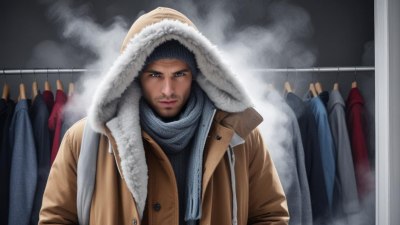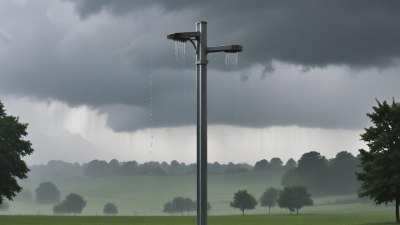What Makes Cold Air So Good at Sneaking Through Your Clothes
Discover how cold air penetrates clothing and its effects on body temperature and comfort.

This image was created with the assistance of Freepik
The sensation of cold air infiltrating our clothing is a common experience, especially during the colder months. This phenomenon can be attributed to a combination of factors including temperature differences, material properties, and the mechanics of airflow. Understanding why cold air is so adept at sneaking through our clothes can help us better prepare for winter weather and stay comfortable. In this article, we will explore the various aspects of cold air dynamics and clothing interaction.
The Science of Cold Air Movement
Air is a fluid and behaves in ways similar to liquids. When there is a temperature difference between the air outside and our body heat, a natural convection current is created. Cold air is denser than warm air; as it moves, it can easily seep into small gaps and openings in clothing. This infiltration happens primarily through the principles of convection and conduction. Convection occurs when warmer air rises and colder air sinks and it can easily penetrate loose or thin fabrics causing an uncomfortable chill.
Material Properties of Clothing
The type of fabric plays a significant role in how effectively cold air can move through our clothing. Certain materials, such as cotton, are breathable, meaning they allow air to circulate easily. This breathability is advantageous in warmer weather but becomes a disadvantage when cold air starts to infiltrate. Fabrics like wool and fleece offer substantial insulation but can still allow some cold air to penetrate, particularly if the clothing is not tightly fitted.
Fit and Layering
The fit of clothing can make a notable difference in how well it blocks cold air. Loose-fitting clothes, while comfortable, create pockets of air that can circulate, allowing cold air to infiltrate more easily. On the other hand, tightly fitted garments can restrict airflow and minimize the penetration of cold air. Layering is another effective strategy to combat cold air sneaking in. By wearing multiple layers, you create barriers that cold air has to penetrate, enhancing insulation through trapped air layers.
Wind Chill Factor
Wind plays a critical role in how cold air interacts with our clothing. The wind chill factor describes how cold it feels based on wind speed and temperature. As wind blows across the skin, it removes the layer of warm air next to our body, intensifying the cold sensation. This is why it’s common to feel much colder on windy days compared to when there is no wind. Fabrics that are both insulated and wind-resistant, like waterproof and windproof outer layers, can help maintain body heat by preventing cold air from reaching the skin.
Humidity and Moisture
Humidity levels also affect how cold air interacts with clothing. Under high humidity conditions, cold air can feel even colder due to the dampness it brings. Moisture can cling to clothing, leading to increased heat loss from the body. When clothes are wet, they lose their insulating properties, allowing cold air to penetrate even more easily. This is why it’s essential to wear moisture-wicking materials close to the skin and to ensure outer layers are waterproof during wet and cold weather.
Thermal Conductivity
The thermal conductivity of materials determines how quickly they transfer heat. Clothing with high thermal conductivity will allow heat to escape rapidly, making you feel colder in cold environments. Fabrics such as polyester and nylon have lower thermal conductivity than natural fibers. Therefore, opting for clothes made of synthetic materials can help to reduce the infiltration of cold air and retain body heat more effectively.
Impact of Body Movement
Movement can also facilitate the infiltration of cold air. Activities such as walking or running can create small gaps in clothing, resulting in increased airflow. As you move, clothing can shift, exposing more skin to the elements. This is why it's crucial to choose garments that are not only warm but also allow for free movement while minimizing the chance for cold air to sneak in.
Technological Advances in Clothing
Advancements in textile technology have led to the creation of highly functional garments that mitigate the penetration of cold air. Companies are now producing specialized fabrics that are both breathable and insulative, creating a better balance between comfort and protection. These fabrics often include features such as windproof membranes and thermal liners that trap warm air while preventing the infiltration of cold air.
Coping Strategies Against Cold Air Penetration
There are several practical strategies one can employ to minimize the impact of cold air sneaking through clothes. First, dressing in layers allows you to adjust your clothing based on varying temperatures. Second, choosing appropriate fabrics can help block air infiltration; look for thermal and wind-resistant clothing. Third, utilizing accessories like scarves, gloves, and hats can significantly reduce the amount of exposed skin, ultimately preventing cold air from sneaking in. Lastly, keeping clothing dry and moisture-free is crucial as wet fabrics conduct heat away from the body more efficiently.
The Importance of Insulating Layers
Insulating layers are essential in maintaining warmth during cold weather. They create a thermal barrier that significantly slows heat loss. Materials such as down and synthetic insulation are excellent choices for jackets and vests as they trap heat and provide a significant barrier against colder air. The effectiveness of insulation can depend heavily on how it's used, such as how well it fits against the body and how many layers you have.
The Psychological Component of Cold
It's worth noting that the perception of cold is not only physical but also psychological. The sensation of cold air permeating our clothing can induce feelings of discomfort and chill, even if the physical effects aren't drastic. Our body's own response to cold can amplify our sensitivity to cold air sneakiness and may lead to an increased desire for warmth and comfort. Therefore, selecting clothing that provides a sense of security and comfort can enhance our overall experience of being outdoors in winter conditions.
Understanding the mechanics of how cold air penetrates clothing allows individuals to make informed choices when dressing for winter conditions. By considering factors like material properties, fit, layering, and utilizing the latest textile technologies, we can significantly reduce the discomfort associated with cold air sneaking in. What's more, appreciating the psychological aspects of our response to cold can lead to a more holistic approach to staying warm and comfortable during chilly days. Emphasizing these elements will empower individuals to face winter weather confidently, knowing that they are well-equipped to battle the cold.











